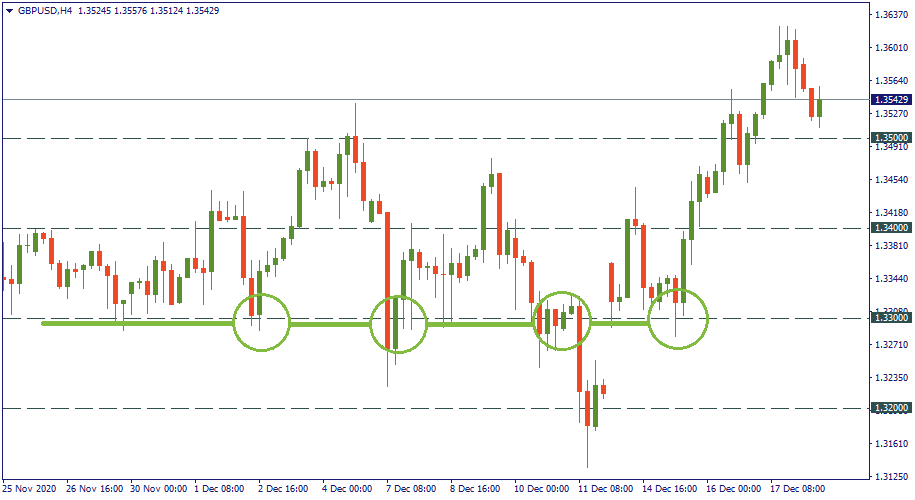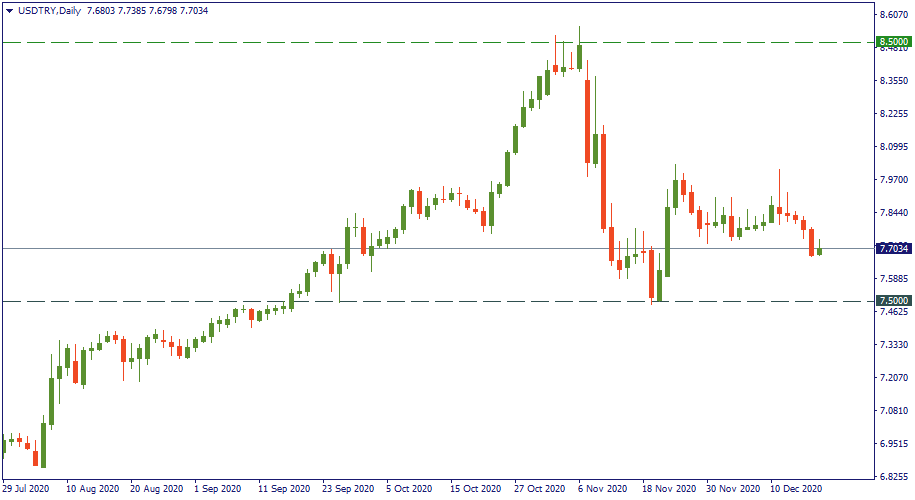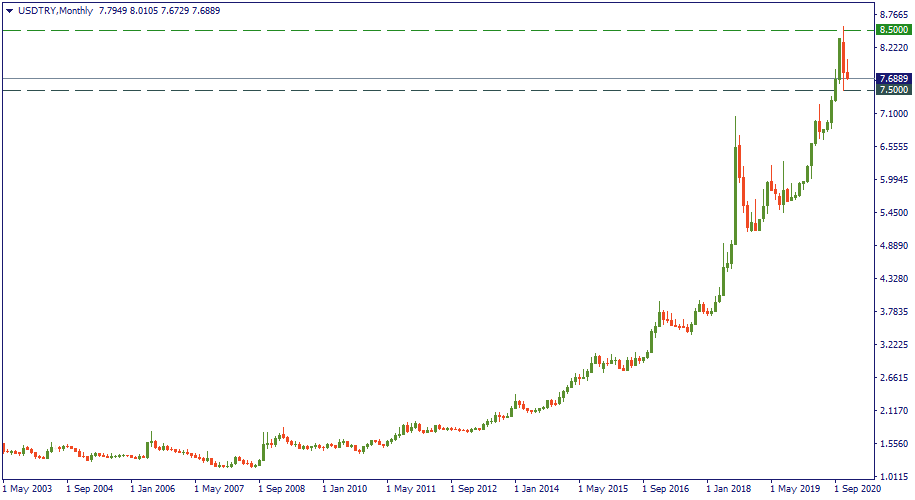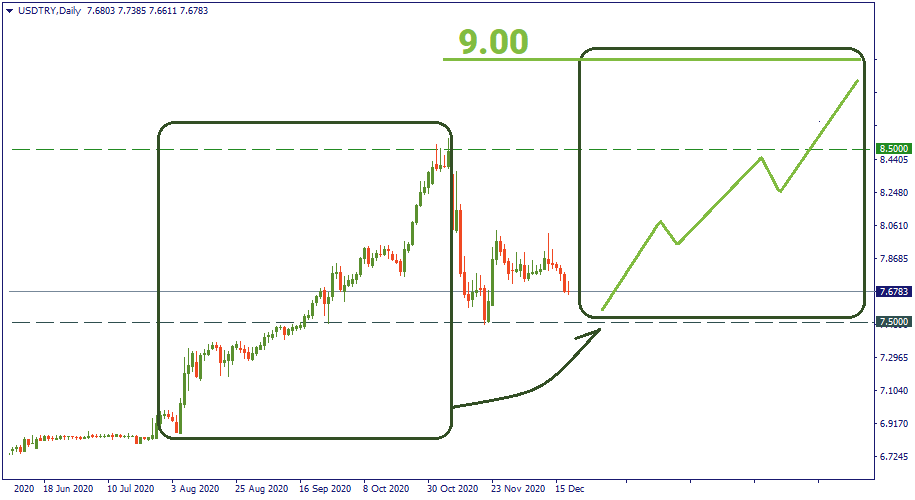
A triangle chart pattern is a consolidation pattern that involves an asset price moving within a gradually narrowing range.
2023-04-03 • Updated
Normally, when we set resistance or support levels, we search for previous lows or highs to do that. For instance, on the H4 chart below, GBP/USD has been revolving around the level of 1.33 for quite a while so it would make sense to choose this level as tactical support. Very convenient, right? Basically, you trade the asset’s past performance.

But what if the currency pair reaches a zone where it’s never been before, an uncharted territory? That’s the case for USD/TRY on the daily chart below. While the support of 7.50 and the resistance of 8.50 get set easily, that only may work for local, intraday trading, and only while the currency pair stays below that resistance of 8.50. But what happens when it comes back up to 8.50 and beats it, how do you set resistance levels?

The first thing to check is a larger timeframe. Sometimes, you just don’t see the price performance far enough into the past: a multiyear low or high may hardly be seen on an H4 or daily chart. Therefore, you need to switch to a weekly or monthly timeframe. But for USD/TRY, the monthly chart below shows that in the last twenty years, the price has never come this high. What to do then, and how to set resistance level here?

What you need to do is to make a chart projection. But before you do that, make sure that no change in the fundamental layout is expected for your asset. It’s like planning a sea route: you came to where you are following a certain current. If the wind changes, the current changes – that will take you in an entirely different direction which you cannot plan for. So, you may only foresee your future position assuming that winds keep blowing in the same direction that’s been the case so far.
Now, observe the speed at which your asset has been following its trajectory. You cannot really foresee accelerations or slowdowns, so your only way to project the price movement into the mid-term and long-term future is to assume it keeps the same pace, on average. Once you do that, you’ll have an expected price movement chart plotted on your screen which now may serve you to set appropriate resistance or support levels. Objective complete.
For example, the daily chart of USD/TRY below. We take its upward trajectory marked in the square on the left side as a basis for extrapolation. That is its normal behavior with no major news or big market movement around. Now, we assume that it will be following a similar trajectory in the foreseeable mid-term future. When we plot it, it doesn’t have to be identical: we just make an approximation of what the most possible scenario for USD/TRY is, under the same fundamental conditions. A hypothetical chart that we get suggests that in about three months, USD/TRY may reach 9.00 from 7.50 just as it went from 7.00 to 8.50 in August-October. Congratulations! Now, we are able to set the resistance at 9.00 and base our trade plans accordingly. The same would work with downward movements.

Keep in mind that this approach is more applicable for mid-term and long-term projections. Short-term, intraday movements are much more distorted by temporary market emotions while the long game ignores that noise. Also, note that you have to include approximate corrections and retracements in your projection. Otherwise, you may end up having an ideal scenario or smooth straight curves that give unrealistic price behavior expectations.
So, when you have all-time highs or all-time lows being beaten, and no reference points in the asset’s previous performance seem to be valid, follow these guidelines:

A triangle chart pattern is a consolidation pattern that involves an asset price moving within a gradually narrowing range.

Sometimes a chart or a candlestick pattern may provide a decent entry signal if it is located at a certain level. A pin bar is one of the most reliable and famous candlestick patterns, and when traders see it on the chart, they expect the price to change its direction soon.

Among hundreds of different indicators and technical tools for traders, the relative strength index (RSI) is one of the most popular due to its simplicity and, at the same time, its power in various trading cases. In this article, we want to tell you about another powerful tool similar to RSI but with some cool tweaks.
If you are 18+ years old, you can join FBS and begin your FX journey. To trade, you need a brokerage account and sufficient knowledge on how assets behave in the financial markets. Start with studying the basics with our free educational materials and creating an FBS account. You may want to test the environment with virtual money with a Demo account. Once you are ready, enter the real market and trade to succeed.
Click the 'Open account' button on our website and proceed to the Trader Area. Before you can start trading, pass a profile verification. Confirm your email and phone number, get your ID verified. This procedure guarantees the safety of your funds and identity. Once you are done with all the checks, go to the preferred trading platform, and start trading.
The procedure is very straightforward. Go to the Withdrawal page on the website or the Finances section of the FBS Trader Area and access Withdrawal. You can get the earned money via the same payment system that you used for depositing. In case you funded the account via various methods, withdraw your profit via the same methods in the ratio according to the deposited sums.
FBS maintains a record of your data to run this website. By pressing the “Accept” button, you agree to our Privacy policy.
Your request is accepted.
A manager will call you shortly.
Next callback request for this phone number
will be available in
If you have an urgent issue please contact us via
Live chat
Internal error. Please try again later
Don’t waste your time – keep track of how NFP affects the US dollar and profit!
